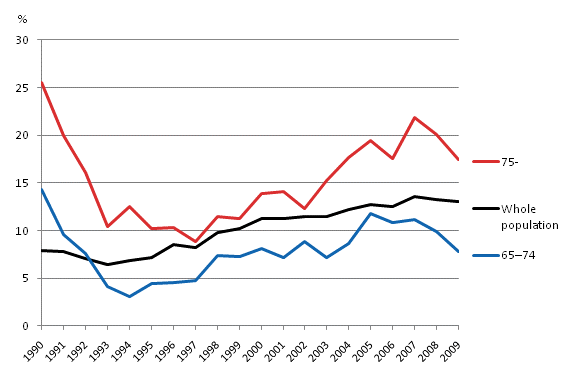Published: 26 January 2011
Low income earning by aged people decreased in 2009
According to Statistics Finland's income distribution statistics, the low income rate was 13.1 per cent of the population in 2009. Around 690,000 persons belonged to households falling below the low income limit. In the previous year the low income rate was 13.2. The annual change is not statistically significant, but differing from the long-term growth trend, low income earning did not rise in 2008 and 2009. At highest, low-income persons numbered 707,000 in 2007.
Low income rate of the whole population, 65 to 74-year-olds and over 75-year-olds (60% of median income) 1990–2009

The number of low-income aged people decreased: the low income rates of both 65 to 74-year-olds and over 75-year-olds went down by around two percentage points. The number of low-income earners grew in the younger population by almost the same number of people.
Examined over a longer term, the low income rate of both aged and other age groups is still high, depending on the age group, double or triple compared with 1993 to 2004.
The internal income differentials of the population falling below the 60 per cent low income limit grew similarly as the year before in the youngest age groups: more and more young one-person households remained below the 50 per cent limit. Four out of five under 35-year-olds one-person low-income households fell below the 50 per cent low income rate. In other low income groups internal income differentials remained unchanged or decreased.
The average euro-denominated growth in disposable income is of the same magnitude below and above the low income limit. The year 2009 was a year of the economic crisis and growing unemployment. In 2009 the average wages and salaries and entrepreneurial income and taxes paid by low income persons were in real terms on level with the previous years, but they received clearly more income transfers. In contrast, the average wages and salaries of the population above the low income level decreased clearly, but taxes paid declined even more. Average income transfers received, especially earnings-related pensions, also grew considerably.
The threshold value used for low income is 60 per cent of disposable median income per household consumption unit, which in 2009 was around EUR 14,200 in a one-person household. The indicator is thus relative, so the changes detected describe the change in the income differential between low and median income groups. The rise in the low income rate represents a growth in income differentials between low and median income groups and a fall evening out of income differentials.
At risk of poverty indicators 1990–2009
| Year | 1990 | 1995 | 2000 | 2004 | 2005 | 2006 | 2007 | 2008 | 2009 |
| Low income figures, income below 60% of median income | |||||||||
| Low income earners | 395 000 | 361 700 | 576 100 | 629 100 | 660 500 | 651 800 | 706 900 | 694 000 | 690 000 |
| Low income rate, % of population | 7,9 | 7,2 | 11,3 | 12,2 | 12,8 | 12,5 | 13,5 | 13,2 | 13,1 |
| Low income limit, EUR per consumption unit | 10 600 | 9 980 | 11 330 | 12 850 | 13 330 | 13 290 | 13 610 | 13 770 | 14 230 |
| Poverty gap of low income earners, % of low income limit | 13,5 | 13,5 | 13,3 | 15,2 | 15,0 | 15,1 | 15,1 | 16,7 | 15,5 |
| Median income of low income earners, EUR per consumption unit | 9 180 | 8 630 | 9 820 | 10 900 | 11 340 | 11 290 | 11 560 | 11 460 | 12 020 |
| Child poverty, aged 0 to 17 | 4,9 | 4,7 | 11,6 | 12,1 | 11,6 | 12,3 | 13,8 | 13,2 | 13,2 |
| Low income rate of employed persons, aged 18 to 64 | 3,4 | 3,2 | 4,3 | 3,8 | 4,0 | 4,0 | 4,6 | 4,2 | 4,2 |
| Low income rate of non-employed persons, aged 18 to 64 | 17,1 | 16,0 | 25,6 | 29,2 | 30,0 | 30,6 | 31,3 | 33,5 | 32,9 |
| Low income rate of men aged over 65 | 10,4 | 3,7 | 6,4 | 8,4 | 10,7 | 10,6 | 11,0 | 9,3 | 8,2 |
| Low income rate of women aged over 65 | 23,5 | 8,6 | 13,1 | 15,6 | 18,3 | 16,1 | 19,6 | 18,3 | 15,4 |
| Low income figures, income below 50% of median income | |||||||||
| Low income earners | 169 100 | 158 100 | 230 500 | 284 300 | 296 200 | 299 100 | 326 900 | 350 600 | 329 700 |
| Low income rate, % of population | 3,4 | 3,1 | 4,5 | 5,5 | 5,7 | 5,8 | 6,3 | 6,7 | 6,3 |
| Low income limit, EUR per consumption unit | 7 590 | 7 020 | 8 270 | 9 260 | 9 670 | 9 660 | 9 600 | 9 760 | 10 210 |
- Poverty gap: Difference between median income among those falling below the low income limit and the low income limit as a percentage of the limit.
- Child poverty: Under 18-year-old children belonging to low income households as a proportion of all under 18-year-olds.
- Euro-dominated values in 2009 money
Source: Income Distribution Statistics 2009, Statistics Finland
Inquiries: Hannele Sauli (09) 1734 3497, income@stat.fi
Director in charge: Riitta Harala
- Tables
-
Tables in databases
Pick the data you need into tables, view the data as graphs, or download the data for your use.
Updated 26.1.2011
Official Statistics of Finland (OSF):
Income distribution statistics [e-publication].
ISSN=1799-1331. Poverty 2009. Helsinki: Statistics Finland [referred: 28.12.2025].
Access method: http://stat.fi/til/tjt/2009/02/tjt_2009_02_2011-01-26_tie_001_en.html

